©
2004 Jeff Matthews & napoli.com
Language/s
(3)
 Here’s
another bit of off–the–cuff anthropology. It is related
to the entry here and my perception that there is less of
a difference between “insider” and “outsider”
in Naples than in many other places. Perhaps it relates also to the
local ability—or lack thereof—to learn foreign languages. Here’s
another bit of off–the–cuff anthropology. It is related
to the entry here and my perception that there is less of
a difference between “insider” and “outsider”
in Naples than in many other places. Perhaps it relates also to the
local ability—or lack thereof—to learn foreign languages.
Anyone
who teaches English as a foreign language abroad (as I do) comes away
with the feeling that some cultures are better at it than others. A
cursory stroll down almost any street or into any store in northern
Europe will leave you with the impression that everyone—say, in
the Netherlands—speaks English. Movies and TV are routinely in
the original language and subtitled in Dutch, and local children will
no doubt hear thousands of hours of English before they get a chance
to study it formally in school. They are primed for French and German
in much the same way. It is a polyglot culture.
In Naples—and
in Italy, in general—everything is dubbed into Italian. Young
people seem to approach the study of another language the way they do
Latin in school—as a dead language, totally unconnected to their
daily lives. They almost never experience English directly. Admittedly,
the onslaught of American popular music has modified that somewhat,
so that a sentence such as “How ya gonna do it if ya really
don’t wanna dance?” is part of the same local perception
of the English language mosaic as, “Little we see in Nature
that is ours;/We have given our hearts away, a sordid boon!” It’s
all English. It’s in the same ballpark. (That can cause a few
problems at exam time. EBL—English as a Ballpark Language? Maybe.)
So, my
sharp and highly intelligent students in Naples don’t really care
that indirect questions follow normal subject-object word order and
not that of direct WH-questions. They say, “Do you know where
is the station?” and are quite amused at my insistence on “Do
you know where the station is?” And I can see “What difference
does it make? You understand me, right?” running through their
minds. Maybe that is related to the fact that Naples is a "survivor
culture". They are a flexible, hospitable and outgoing people—and
totally undemanding of you when it comes to your own ability
to speak their language. They will gratefully accept any kind of Italian
from you and thank you for it and sincerely compliment you on it. You
become an “insider” almost by declaration. You say in your
worst Italian, “Hey, I want to belong” and their answer
is “Fine. No problem.”
You communicate
anyway, even without proper verb conjugations, and those little niceties
of language fall by the wayside as the difference between insider and
outsider gets more and more muddled. You communicate, and it is almost
like being present at one of those mighty births of creole language
that linguists tell us occur when cultures and languages blend. Thus—here’s
the point (you knew there had to be one in here, somewhere!)—Neapolitans
are as willing to accept their own mistakes in other languages as they
are to accept your mistakes in theirs.
Yes, there
are cultures in the world that are so xenophobic that they reject any
attempt on your part to speak their language, much less take out membership
in that culture. If that is one end of the spectrum, there certainly
must exist cultures at the other end—the place where all the “flexible,
hospitable, outgoing and undemanding” xenophiles gather and get
along.
Anacapri
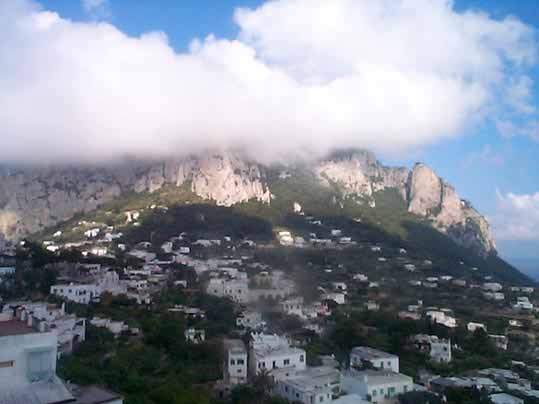 Looking
from the town of Capri towards Montesolaro and Anacapri. Looking
from the town of Capri towards Montesolaro and Anacapri.
My friend,
Bill, keeps encouraging me to read Graham Greene because that author
is so depressing, cynical, and writes so well. Thus, almost at random,
I found this from Greene's This Gun for Hire.
| He
had been made by hatred; it had constructed him into this thin
smoky murderous figure in the rain, haunted and ugly. His mother
had borne him when his father was in gaol, and six years later
when his father was hanged for another crime, she had cut her
own throat with a kitchen knife; afterwards there had been the
home. He had never felt the least tenderness for anyone; he had
been made in this image and he had his own odd pride in the result;
he didn't want to be unmade. |
Is there
a special reason why the person who wrote that passage—almost
a caricature of Evil—chose to live in Anacapri, or why he called
attention to the fact that he regarded the town not only as a place
to have a house, but a home, or why he was especially proud of the honorary
citizenship bestowed upon him by that community?
The passage
cited has at least a little to do with Greene's perception of the presence
of evil in the world. It's everywhere. The world, after all, is a seedy
and decaying pit with absolutely no guarantee that good will win out,
for there is no assurance that good persons in the world can be counted
on to do good. It may go even further than that: there may be no good
persons to speak of! Or, at least, if there are, they are helpless in
the face of the irresistible nature of evil. It is stronger than we
are. What, however, does that have to do with Capri, and, specifically,
Anacapri?
Perhaps
it is best to think of the Isle of Capri precisely the way it looks
as you approach it from the sea—as two different places. And for
those of you who don't know, those of you who have blindly accepted
the arrogant cartographic hoodwink that 'Capri' is Capri, well, that's
not so. The island is, in fact, two different places: one low and one
high—Capri and Anacapri. According to a good source of mine, a
young woman from Anacapri, this physical configuration of the island
corresponds perfectly to the differences between the residents of the
two towns, Capri and Anacapri, in that the Anacapresi are morally and
spiritually superior to the inhabitants of the town of Capri. After
all, she claims, monks don't go down into mineshafts to meditate, they
go to the tops of mountains. And since she is morally superior, she
wouldn't lie about that, either.
Look at
the infamous piazzetta, the town square of Capri. Here you find prodigal
ne'er–do–wells wallowing in cafes and bars, smoking and
lounging on the steps of a church (!), aimlessly wandering around, drinking
too much and buzzing too much in that nervous stirred-up fashion of
swarming insects trying desperately not to notice that the façade
they are clinging to is cracking. These are, you must admit, at least
potentially "smoky murderous figures" (see above). (For you democrats
out there, we are not presuming guilt, here, merely presuming evil—an
entirely different matter.) These are your jet-setters, the 'lovely
people', people out for a 'good time' ('good', of course, not in the
proper theological sense of 'morally correct' but in the perverted modern
sense of 'that which produces ephemeral physical pleasure and a nice
suntan'). Here is where you can well imagine a character in one of Graham
Greene's novels sitting and brooding about having been 'made by hatred'
or being 'haunted and ugly' and not 'feeling the least tenderness for
anyone'.
On the
other hand, high up the hill, past the protective bulwark of the hermitage
of S. Maria Cetrella perched on the cliff, and, thus, well above Man's
Fallen State, iniquity gasps like a carp out of water. There lies Anacapri,
where there is only one real square, to speak of, and that is in front
of the Church of Santa Sofia. There is no brooding or sulking here,
either. (It is illegal ever since the town fathers erected that 'No
Brooding or Sulking' sign that dominates the square). It is here that
we truly realize for the first time why 'Anacapri' and 'good' rhyme
(at least they do in Lepcha, a minor dialect of the Sino-Tibetan family
of languages, but perhaps I digress).
Not only
that, but the square of Santa Sofia is only a few minutes from the chair–lift
to the top of Monte Solaro. If and when the Evil–alarm went
off, Graham Greene was just a moment away from salvation, from transcending,
moving ever upward like Dante after Beatrice, or Goethe after the royalties
on Faust, for Evil, especially southern Mediterranean Evil, has been
shown not to be particularly viable above 250 metres, unless there is
a lot more annual rainfall than one normally finds on the slopes above
Anacapri (see "smoky murderous figure in the rain", above). All in all,
then, perhaps it is only in Anacapri that Graham Greene may have been
somewhat less convinced of the all–pervasiveness of Evil. And
that's not so bad, is it?
Cimarosa,
Domenico (1749-1801)
 Cimarosa was the most highly regarded
Italian composer of his day (this, just in case you have been tricked
by the film Amadeus into thinking that this honor belongs to
a Viennese court composer by the name of Salieri). Cimarosa was the most highly regarded
Italian composer of his day (this, just in case you have been tricked
by the film Amadeus into thinking that this honor belongs to
a Viennese court composer by the name of Salieri).
Cimarosa
was born in Aversa near Naples and was admitted to the Conservatorio
di S. Maria di Loreto in 1761 where he made rapid progress
as a violinist, keyboard player, singer and, above all, a composer.
He left the conservatory in 1771. He first gained a broader reputation
by his contributions to the opera buffa, the unique Neapolitan
music form that had become the rage of Europe ever since Pergolesi's
La Serva Padrona decades earlier. Cimarosa's early works such
as Le stravaganze del conte, Le magie di Merlina e Zoroastro,
Il ritorno di Don Calandrino, Le donne rivali, and Il
pittore parigino belong to the rather large body of light-hearted
and neglected music from the 18th century, much of which has simply
been historically overrun by works in the same vein by Mozart
and Rossini, as well as by the changing tastes in music
when all of art was swept into the great age of Romanticism.
In
1785 Cimarosa was appointed second organist of the Neapolitan
royal chapel and also held an appointment at the Ospedaletto conservatory
in Venice. In 1787 Cimarosa accepted the position of maestro di
cappella at the St. Petersburg court of Catherine II. On
the way to Russia, Cimarosa made the acquaintance of the Grand
Duke Leopold of Tuscany, who later, as emperor (1790-92) would be
helpful to him during his stay in Vienna. He also met Caroline, the
Vienna-born wife of King Ferdinand of Naples—a woman who would
loom large in his own future in another few years.
Cimarosa
stayed in St. Petersburg until 1791. He was one of a long line of Italian
composers employed by the Czarina. He returned to Vienna where he was
appointed Kapellmeister by Leopold II. He wrote a number of comic operas
there, most notable of which was Il matrimonio segreto, based
on The Clandestine Marriage, a farce by Colman and Garrick from
1766. It was enormously successful and is, today, still one of the very
few Neapolitan comic operas in the standard repertoire of opera companies
in the world. It usually runs in Naples every two or three years.
He returned
to Naples in 1796 and became the first organist of the royal chapel.
He immediately became embroiled in the politics of the day, that is,
the republican fervor sweeping Europe in the wake of the French Revolution
of 1789. When the Neapolitan Republic was declared in 1799 and the royal
family fled from Naples to Sicily, Cimarosa lent his skills to
the cause of the new Republic and composed a patriotic hymn that became
the "national anthem" of the Republic.
When the
Republic fell and the Bourbons returned to power in Naples, Cimarosa
tried to make things right by composing some music for his old acquaintance,
Queen Caroline, and her husband, King Ferdinand. Both king and queen,
however, were hell-bent on revenge, and Cimarosa was one of the one-thousand
"Republicans" put on trail for treason. He spent four months in prison
and was spared execution probably by the intervention of his friends,
Cardinal Ruffo and Lady Hamilton, and
by his own plea at his trial that we was merely a composer. Yes, he
had composed that Republican hymn, but he had also written music in
honor of the royal family. That's what composers do: you pay them, they
compose music. Whatever the reason, the "hanging judges" of the Bourbon
tribunal let him go with exile. Cimarosa moved to Venice where he died
in 1801. Despite rumors that Queen Caroline of Naples had him poisoned,
he most likely died of natural causes.
[Other
items related to the Neapolitan Republic are:
The Bourbons in Naples (1)
Eleonora Fonseca Pimentel ]
Though
now overshadowed, Cimarosa enjoyed vast renown during his lifetime.
His 60 stage works were performed in all the major European capitals.
He was praised by the likes of Goethe and Stendahl. His music was vigorous,
yet elegant and delicate—of the kind that is today termed "Mozartean"—particularly
the orchestral passages in, say, Il matrimonio segreto. Ironically,
that work was premiered in Vienna in 1792, the same year that Mozart
died there. It is, perhaps, an understandable quirk of history that
relegates fine artists such as Cimarosa to obscurity in comparison to
their larger-than-life contemporaries; in this case, that would be Haydn,
Mozart and Beethoven. Tough competition, indeed.
[See,
also: The Naples Conservatory and Mozart
and The Neapolitan Comic Opera.]
Albergo
dei Poveri (Royal Poorhouse)
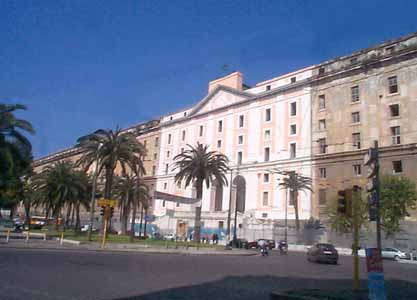 When Naples is viewed from a certain height, one of
the most visible structures in the city is the gigantic Hospice for
the Poor on via Forio. As they say, you can’t miss it. It is 300
yards long and five stories high (17th-century stories, meaning about
as high as 7 or 8 modern ones). Decayed façade, windows gone,
upper floors and much of the roof fallen in, it’s a shell—a
dead mastodon that has simply not yet fallen over. I have passed it
a thousand times and thought, “Either do something with it or
knock it down”. When Naples is viewed from a certain height, one of
the most visible structures in the city is the gigantic Hospice for
the Poor on via Forio. As they say, you can’t miss it. It is 300
yards long and five stories high (17th-century stories, meaning about
as high as 7 or 8 modern ones). Decayed façade, windows gone,
upper floors and much of the roof fallen in, it’s a shell—a
dead mastodon that has simply not yet fallen over. I have passed it
a thousand times and thought, “Either do something with it or
knock it down”.
About six
months ago, they restored the façade around the main entrance
to the building, so it seems they have taken the first option. I finally
got into the building yesterday on a guided tour and, indeed, there
is considerable clean-up going on of rubble and the accumulated junk
of decades of neglect, a job that has to be done before real restoration
of the building can take place.
The Hospice
for the Poor was ordered built in 1751 by Charles III, the first Bourbon
King of the Kingdom of Naples. It was designed and started by Ferdinando
Fuga and then continued by Luigi Vanvitelli, the great architect of
the Bourbon Royal Palace in Caserta (the so-called “Versailles
of Italy”). The idea, in those days, of constructing a mammoth
poor house along via Foria, one of the principle entrances to the city
of the eighteenth century, was in keeping with promoting the image of
Charles III as an enlightened monarch and the image of his kingdom as
one of compassion. It was also in keeping with a wave of such “social
construction” throughout Italy in that century in the form of
poor houses, hospitals and communal granaries. (Indeed, in Naples, there
was even a grotesquely efficient paupers’ graveyard with a numbered
communal plot for each day of the year.)
The original
plan for the Hospice was to have one long façade fronting five
internal courtyards, the central one of which would house a high-domed
gigantic church that was to be the inner hub of the entire building;
from that hub, passage ways were to radiate out to dormitories, dining
halls, workshops, and gardens. It was actually envisioned as a sort
of self-sufficient small village. The intentions of Charles III were
never fulfilled. The anti-clericalism of French rule between 1806 and
1814 in Naples put an end to the central church, and two of the five
courtyards were eliminated, thus giving the present configuration of
one central courtyard and one on each side. Thus, by 1820 the plan to
build a poor house bigger than most royal palaces had become much less
ambitious.
That part
of the building that had been finished, however—and it was impressive—
remained in use through WW2, and in its long history the Hospice has
housed everything from trade schools to hospitals to the back-up archives
for the city of Naples. After WW2 they even put in a football field
in a courtyard to keep the local kids out of trouble. Also, there are
currently some 85 families living in the building, housed in flats around
the courtyard behind the east third of the façade. They are,
by now, the grandchildren of the needy families that were situated there
after WW2. Thus, even in its unfinished state, it has served the city.
Real neglect
began after WW2, and the last 50 years have been a disaster. Also, the
building suffered considerable damage in the earthquake of 1980; yet,
the consensus is that it is still structurally sound. In 2002 the main
entrance and adjacent rooms were restored as part of a "teaching project"
to help build a cadre of masons, builders and artisans trained in historical
restoration. The restored section is open and houses exhibitions of
one sort or another. In February 2003 plans will be approved to restore
the entire building by 2006. They call for a restoration to the "unfinished"
state of the early 1800s. That is, no attempt, for example, will be
made to build the mammoth church that was originally planned for the
main courtyard of the building. The various rooms will then be available
for various functions and possibly even private enterprises that do
not "offend" the history of the building. No MacDonald’s on the
premises, one may assume.
Grand
Tour
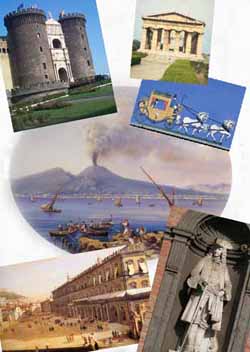 I
was chugging down Via Caracciolo the other day on my four 14-year-old
cylinders. The 18th-century Royal Gardens—now a public park—were
on my left, and coming up on the right was the Castel dell'Ovo,
built on the site of the original Greek settlement of Naples, later
also the site of the last prison of the last emperor of Rome. I was
sort of enjoying the 'history' of it all, when I noticed a gigantic
tour bus in the rear-view mirror, about ready to blast by me. They were
in a hurry—definitely not on a Grand Tour. I
was chugging down Via Caracciolo the other day on my four 14-year-old
cylinders. The 18th-century Royal Gardens—now a public park—were
on my left, and coming up on the right was the Castel dell'Ovo,
built on the site of the original Greek settlement of Naples, later
also the site of the last prison of the last emperor of Rome. I was
sort of enjoying the 'history' of it all, when I noticed a gigantic
tour bus in the rear-view mirror, about ready to blast by me. They were
in a hurry—definitely not on a Grand Tour.
If you
define 'grand' as 'extravagant' or 'leisurely' or 'relaxing', then whatever
else traveling is these days —fast, convenient, cheap— one
thing it is not is 'grand'. I say this in spite of being totally
seduced by the idea of sub-orbiting from Europe to Japan in two-and-a-half
hours aboard a hypersonic ram-jet spaceplane. But it will still take
me forever to fight my way through traffic from my house to the hypersonic
ram-jet airport, and once aboard, I will be force-fed hypersonic ram-jet
spaceplane food, and at my destination be corralled into a holding pen
waiting for one surly bureaucrat to rummage through my underwear while
another compares my passport photo to Interpol mugshots. Good, you get
there, but 'grand' it ain't.
'Grand',
as in The Grand Tour, means going back to the eighteenth and early nineteenth
century and taking a few months off to travel around Europe and complete
your education on lots of daddy's money. You traveled by ship, train
(from the early 1800's onward) and horse-drawn barouche or dormeuse.
You didn't wear bowling-shirt and tennis shoes, either. You packed burnouses,
cloaks, frocks, spencers, waistcoats and a nice selection of cravats
and collars —after all, you would be dressing for dinner, a leisurely
affair with educated conversation before, during and after, enlivened,
of course, by your own sparkling wit.
The Grand
Tour was the last act in the eighteenth-century English and northern
European gentleman's coming of age. You had just spent your entire formative
years studying things like alea iacta est ("The die is cast").
You had totally ignored, of course, the glorious daredevilry of Caesar's
words as he crossed the Rubicon, and had concentrated, instead, on what
the correct Latin would have been had Julius wanted to say something
like, 'The die would have been cast,' or, maybe, 'Might have been cast,'
or, even 'Hey, what happened to the other die?'
Now you
were off to do some cultural empire building of your own: around the
Continent —Paris, Vienna and then the grand finale of the Grand
Tour, south to Italy—across the Alps and down into sun, music,
art, romance, hurtling back to the dark intrigues of Renaissance Italy,
then back further to the glories of Imperial Rome, to the beginnings
of Christianity and then the ancient Greek outposts of the southern
peninsula. For well over a century, young northern gentlemen swarmed
through Italy so they could get what a thousand books could not give
them, so they could personally explore millennia of history upon which
their civilization was built, so they could tread where Michelangelo,
Dante, Augustus, Virgil, Peter, and even Ulysses had trod.
Byron,
Shelly, Goethe, Mozart, Stendahl… and on and on—they all
came to Italy, and most of them came to Naples, the southernmost point
on the standard Grand Tour. In the 18th century, visitors to Naples
found a city rebuilt by Charles III of Bourbon: royal palaces, broad
streets, the finest opera house in the world —a city entirely
to suit the opulent tastes of the monarch and then of his Habsburg daughter-in-law
who would run the kingdom (while her milksop husband 'ruled') until
well into the19th century.
Visitors
thus enjoyed the splendor of the modern absolute monarchy. It was here
that Stendahl, at the reopening of the San Carlo Theater said that he
felt as if he had been "…transported to the palace of some oriental
emperor…my eyes were dazzled, my soul enraptured. There is nothing
in the whole of Europe to compare with it." It was here, too, that even
the sombre Goethe—who complained that his "German temperament
and determination to study" kept him from amusing himself—relaxed
enough to write:
| I
can't begin to tell you of the glory of a night by full moon when
we strolled through the streets and squares to the endless promenade
of the Chiaia, and then walked up and down the seashore. I was
quite overwhelmed by a feeling of infinite space. To be able to
dream like this is certainly worth the trouble it took to get
here. |
Perhaps
he begrudged the natives their easygoing approach to life more than
a little when he observed that in Naples "…as long as the queen
is pregnant and the king is off hunting, all is right with the world."
But, primarily,
they got the past they had come for. Naples is where classical Greece
first came ashore beyond the Aegean; even the mysterious Etruscans and
Samnites had been in Naples; Hannibal had laid siege to it, and Spartacus
had led his revolt on the nearby slopes; here Brutus plotted the assassination
of Julius Caeser; here the last emperor of the Western Empire was exiled;
nearby was the mythological descent into the Underworld, and Virgil
wrote the Aeneid here—indeed, the poet is buried in Naples, and
his tomb is a shrine now as it was during the age of the Grand Tour.
Visitors were fortunate enough, too, to get in on the first massive
modern excavations of Pompeii and Herculaneum. They could climb famed
Vesuvius, the eruption of which had killed Pliny the Elder and destroyed
Pompei, an event which moved Grand Tourist Shelly, 1,800 years later,
to pen in his Ode to Naples:
I
stood within the city disinterred;
And heard the autumn leaves like light footfalls
Of spirits passing through the streets;
and heard The mountain's slumberous voice at intervals
Thrill through those roofless halls.
The oracular thunder penetrating shook
The listening soul in my suspended blood.
I felt that Earth out of her deep heart spoke… |
So, as
the bus went by me I frantically signaled to the tourists trapped within.
I made what I was sure were universal gestures for "18th century royal
gardens" and "…the last prison of the last emperor of Rome". Stop,
I said, beckoning them to tarry a while and partake of genteel discourse—in
short, to 'get grand'. It was too late. They were gone, on their way
back to the airport.
Immigration
(2), Neapolitan culture (4),
extracomunitari, urbanology (3)
In Italian,
the term extracomunitari refers to those persons from outside
the European community. Technically, that includes Canadians, citizens
of the USA, Australians, and Martians—and it is true that citizens
of those countries and planets stand in the extracomunitari queue
in airports. Yet, in general terms, everyone in Naples knows what extracomunitari
really means. It refers to Asians, Africans and people from the Balkans
who wash up on southern Italian shores in search of a new life. Very
often, they really do wash up on the shores, having been abandoned by
heartless refugee smugglers who think nothing of dropping a pregnant
woman into the sea, 100 yards from shore, and speeding off to pick up
another boatload of people who will do anything to get into Europe.
These people
who have deserted their homes, families, friends, and native language
in Albania or Morocco, or wherever, generally find Naples to be a city
with a good heart. (I have never (!) heard a racial slur against
these people. You know—“Hey, why don’t all these black
people go back where they came from.” I have heard: “Are
you nuts? We haven’t got any jobs for ourselves! But if you want
to slog it out on the streets, more power to you.”)
Many of
the immigrants wind up in the grey world of peddling wares of one sort
or the other on the streets, either on Via Toledo or Corso
Umberto, two of the main drags in town. They lug their goods to
and fro in those huge zippered duffel bags of the kind that scuba divers
use. They generally set up right on the sidewalk: first a tarp—or
maybe just large piece of cardboard—on the ground, and then they
unload the leather handbags and belts, assorted trinkets, even small
African musical instruments and carved animals. Some of those may even
have been carved in Africa, though maybe they were done at “home”
in Torre del Greco, a town near Naples right on the slopes of Vesuvius.
Many of the African extracomunitari live there, sharing flats—nothing
unusual in what is, anyway, the most densely populated area in Europe.
Usually,
they are left alone, even by the police. Yet, there is such a thing
as “vendor overload” on any given street, I suppose, and
if they are set up right in front of your store on the sidewalk and
selling tax-free contraband handbags and draining customers away from
your shop that sells the real taxed deal—well, then, you are going
to call the cops and let the chips fall where they may.
That’s
what happened yesterday on via Roma. The police move in on street
vendors with all due lack of deliberate speed. The point is not to arrest
25 poor bastards and confiscate their stuff; the point is to roust them,
send them packing and give the merchants of the area a breather. The
extracomunitari peddlers have a nose for trouble and the minute
the roust starts up at the end of via Roma, the grapevine is
electrically fast; within seconds they are gone—right down to
the end of the street they have packed up and left in no time flat.
Yesterday,
a young Senegalese by the name of Djouf was a bit slow in gathering
up his stuff. He got the word —“Cops!”— but
he stuck around a second or two longer than the others, just to make
sure that he hadn’t left any of his wares behind on the sidewalk.
That’s when the police moved in on him, as the law provides, to
“check his papers”. And that’s when the street people
moved in on the cops. A crowd of residents of the popular Spanish Quarter
quickly surrounded the “Forces of Order” (as the Italian
euphemism has it) and demanded Djouf’s release. Push came to shove,
but the long and short of it is that the police backed down. Djouf not
only got released but was carried away on the shoulders of the crowd,
like in Hollywood where Robin Hood gets sprung from the clutches of
the king’s men by the villagers. It is certainly not that simple.
The police chief’s view in the papers today was, “Fine.
You tell us what you want us to do. You called us, remember?”
Taxis,
petty theft (2)
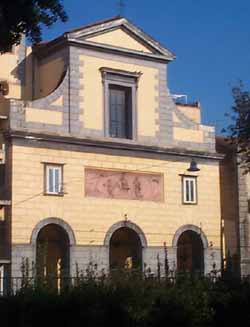 I
have a normal and healthy paranoia when it comes to taxis. I know that
the driver is going in circles and even weirder geometries just to run
up the fare on me. He recognizes me as a stranger in a strange land
and is taking me to the cleaners even though that establishment is nowhere
near my house. So, in an unwonted eruption of fairness, I inform you
that the other day a Naples cab driver got his picture in the papers.
He found a bag with twelve-thousand euros (a tad more than $12,000)
in the back of his cab, did a bit of sleuthing in his passenger-log
for the day and figured out who it might have been. He was right. One
phone call and the lucky passenger got his money back. The consensus
of opinion at the local coffee bar is that if the sum had been ten times
that amount, then it could only have belonged to a plutocrat swine who
would have deserved to lose the money. This is solid trickle-down economics
that we tamper with only at great peril. On the other hand, twelve grand
is a lot of money, but it’s not a fortune. I offered the view
that “maybe it was a guy just like you or me”. The bar-owner
smiled and said, “Do you walk around with that kind of money in
your pocket? If so, step into the back room. I have a black-jack I would
like you to meet.” The jury hung and we declared a mistrial. I
have a normal and healthy paranoia when it comes to taxis. I know that
the driver is going in circles and even weirder geometries just to run
up the fare on me. He recognizes me as a stranger in a strange land
and is taking me to the cleaners even though that establishment is nowhere
near my house. So, in an unwonted eruption of fairness, I inform you
that the other day a Naples cab driver got his picture in the papers.
He found a bag with twelve-thousand euros (a tad more than $12,000)
in the back of his cab, did a bit of sleuthing in his passenger-log
for the day and figured out who it might have been. He was right. One
phone call and the lucky passenger got his money back. The consensus
of opinion at the local coffee bar is that if the sum had been ten times
that amount, then it could only have belonged to a plutocrat swine who
would have deserved to lose the money. This is solid trickle-down economics
that we tamper with only at great peril. On the other hand, twelve grand
is a lot of money, but it’s not a fortune. I offered the view
that “maybe it was a guy just like you or me”. The bar-owner
smiled and said, “Do you walk around with that kind of money in
your pocket? If so, step into the back room. I have a black-jack I would
like you to meet.” The jury hung and we declared a mistrial.
The seamier
side of human nature—and this one restores my faith—has
to do with the small local Church of San Giuseppe a Chiaia (photo) just
across from the Villa Comunale, the large public gardens that
extend along the seaside from Mergellina to Piazza Vittoria.
One of the priests noticed that the same gentleman came in early every
morning to pray. He always sat in the same pew near a small collection
box, a simple affair secured with a locked, hinged top with a slot in
the top where you can drop in a few coins if the spirit so moves you.
The priest also noticed that the collection box—far from being
coinful unto overflowing from the generosity of the previous day’s
faithful—was empty most of the time. Sleuthing, again, came into
play, the inductive chain proceeding thusly: (1) box full of coins;
(2) man comes in; (3) man goes out; (4) box empty. Eleemosynary, Watson!
An undercover cop—posing as I’m not sure what…a confessional?—caught
the scoundrel extracting coins back out of the box through the slot
using a wooden stick with a piece of chewing gum on the end of it. “But
I was just ‘doing alms’—as our Lord and Saviour bade
us,” he said. This radical approach to New Testament hermeneutics
did not wash with the judge. The blackguard got 3 months. He has promised
to reform—or at least change churches. Maybe he will apply for
a job as a cabbie.
Streets
(1)
Lovely
Rita, a dear friend who used to live in Naples, has just written. She
says:
| Last
weekend we were in San Francisco and we drove the kids down Lombard
Street which claims it is the crookedest street in the world.
I remember a street in Naples that was kind of hidden that was
at least equally as crooked. I believe it ended up at Mergellina…what
can you tell me about this very old street? |
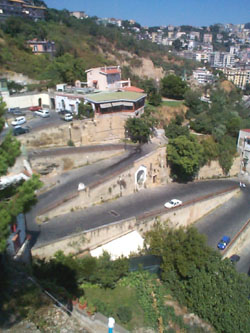 I'm
not sure. She has described a number of streets in that area. She might
be talking about Rampe S. Antonio (photo), a road that makes
seven 180–degrees turns to navigate down the hillside from above
the Church of Piedigrotta and comes out a couple of blocks
from the small Mergellina harbor. It's not a major thoroughfare,
so maybe that doesn't count in the "world's crookedest street" contest.
Off hand, however, I can think of a few busy roads in the city that
make two or three "180s" with a few right–angle turns thrown in
over the length of half a mile or so. I'm
not sure. She has described a number of streets in that area. She might
be talking about Rampe S. Antonio (photo), a road that makes
seven 180–degrees turns to navigate down the hillside from above
the Church of Piedigrotta and comes out a couple of blocks
from the small Mergellina harbor. It's not a major thoroughfare,
so maybe that doesn't count in the "world's crookedest street" contest.
Off hand, however, I can think of a few busy roads in the city that
make two or three "180s" with a few right–angle turns thrown in
over the length of half a mile or so.
That is
what happens when a city is spread from sea level to about 600 feet,
as is Naples; roads have to be either very crooked or very steep and
maybe even both. For pedestrians there are also four heavily–used
cable–cars in Naples. (They are also termed “funicular railways,”
as in "Funiculì–Funiculà,”
though that song was written about the long–gone cable–car
on Vesuvius). And only brave sherpa Tenzing Norkay would feel much like
singing on the way up the many stairways that web the hillside.
The original
Greek (and then Roman) city was laid out on a neat grid of symmetrical
blocks. (Pythagoras, himself, would whack a stone surveyor’s tripod
across your brow if you tried to sneak in even one little dogleg.) There
were no crooked roads. After centuries of wandering around in
the Dark Ages, however, people had simply reinvented crookedness on
their own. Then, in the sixteenth century, the Spanish straightened
a lot of that out. Ironically, the Baroque—known for complexity
and ornateness—oversaw the construction of broad, straight roads
in Naples for the first time in 1500 years. The famous Spanish Quarter
in Naples was built during that period. (I include a quote from the
entry for July 5 about the Spanish Quarter)—
| Here,
one does well to recall Lewis Mumford’s remark that
the clearing away of the small winding medieval streets of Paris
by Napoleon III in the mid-nineteenth century did away with the
last physical barrier which protected the common citizen from
the power of the absolute state. Such was the case in Naples —
a long rebellious nest of medieval clutter into which the King’s
soldiers ventured at considerable risk was made more manageable
by the introduction of broad straight roads that were easy to
patrol. |
If my friend is looking for steep streets, I think via Kagoshima takes the
prize in Naples, though others come close. That's the name, tooóKagoshima.
That Japanese city and Naples have paired off in one of these "sister
city" affairs. Presumably, in Kagoshima there is a street named after
Naples. I took a carpenter's level over to via Kagoshima the other day
just to check my little car's complaint that the street has a 45Ėdegree
grade, at least in part. The tiny air bubble went way over to one side. I
don't think I got an exact readout of 45 degrees, but I remember thinking
that if I used that carpenter's level to make tables like that, I could
sell them to people who just wanted to sit at one end and have all their
food roll down to them.
We don't
worry too much about crooked and steep; it's "holeyness" we are concerned
with. We had a sink-hole a few years ago up on the Vomero hill, above
the main part of Naples, that opened and swallowed a filling section.
Folklore already insists that the filling station has never been found.
It has become a Texaco Flying Dutchman, doomed to sail the netherworld
of Naples forever.
Circus—
 There
is cause for rejoicing under the big–top today. At the same Moira
Orfei circus, a Siberian camel named “Tibet” gave birth
the day before yesterday to a bouncing baby girl, named “Magic”
(after the “Magic World” amusement park where the circus
is running). The calf is healthy and as snow white as her mother. Mother
picked a good day for the event; the circus was taking its one day in
the week off; this gave jugglers, clowns, and acrobats a chance to pace
worriedly and pretend they know something about dromedary obstetrics.
By the way, There
is cause for rejoicing under the big–top today. At the same Moira
Orfei circus, a Siberian camel named “Tibet” gave birth
the day before yesterday to a bouncing baby girl, named “Magic”
(after the “Magic World” amusement park where the circus
is running). The calf is healthy and as snow white as her mother. Mother
picked a good day for the event; the circus was taking its one day in
the week off; this gave jugglers, clowns, and acrobats a chance to pace
worriedly and pretend they know something about dromedary obstetrics.
By the way,
| Middle
English dromedarie <Old French dromedaire <Latin
dromas < Greek dromas, a runner <dramein,
to run < Indo.European base *drem–, *dreb–,
to run, whence Sanskrit drámati [he] runs, TRAMP.) |
[Don’t
you get the feeling that etymologists are just having a good time with
you sometimes?]
Anyway,
the father, Pippo, is also doing well and is strutting his hump around
the tent.
Like many,
I have mixed feelings about animals in zoos and circuses. I went to
the Naples zoo once many years ago and vowed never to go back. They
had a beautiful Siberian tiger in a very confined space, and the animal
had obviously gone “stir crazy”. I wanted somehow to release
it and let it run out and go down fighting—after it polished off
a band of obnoxious teenaged moron who were taunting their chimpanzee
first-cousins in a nearby cage by throwing debris through the bars.
Emigration,
immigration (3)
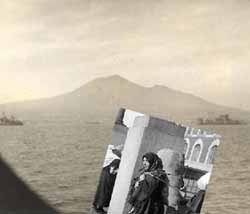 Emigration
occupies a good deal of space in the collective psyche of southern Italy.
Everyone seems to have a brother, cousin or uncle who has gone away
to find work and never come back. Indeed, even though the great waves
of emigration from southern Italy of the early 20th century are well
behind us, great cites around the world still have sections of town
called “Little Italy”. By now, they are inhabited by the
grandchildren and great-grandchildren of those who left southern Italy
in such numbers that their villages of origin in the mountains of Calabria,
Puglia and Campania are, to this day, ghost towns. In Naples, today,
if you are pulled over for a traffic violation, you might be lucky enough
to have the traffic cop look at your non-Italian name, ask you where
you’re from, smile and say, “Hey, my relatives lives in
California! Say, you know, you really shouldn’t be speeding like
that on the sidewalk outside a major hospital. Well, run along. Just
be careful.” Emigration
occupies a good deal of space in the collective psyche of southern Italy.
Everyone seems to have a brother, cousin or uncle who has gone away
to find work and never come back. Indeed, even though the great waves
of emigration from southern Italy of the early 20th century are well
behind us, great cites around the world still have sections of town
called “Little Italy”. By now, they are inhabited by the
grandchildren and great-grandchildren of those who left southern Italy
in such numbers that their villages of origin in the mountains of Calabria,
Puglia and Campania are, to this day, ghost towns. In Naples, today,
if you are pulled over for a traffic violation, you might be lucky enough
to have the traffic cop look at your non-Italian name, ask you where
you’re from, smile and say, “Hey, my relatives lives in
California! Say, you know, you really shouldn’t be speeding like
that on the sidewalk outside a major hospital. Well, run along. Just
be careful.”
It is difficult
to leave home, and, for whatever reason, it is very difficult for Neapolitans.
The 1925 tear-jerker evergreen of the emigrant Neapolitan song is “Lacreme
napulitane”. It is in the form of a letter from America, written
home by a son to “dear mother” in Naples. It is a lament
of how difficult it is to be far from home, away from the sound of the
zampogna, (the Neapolitan bagpipes, traditional at Christmas),
and away from the “sky of Naples”. The refrain starts with
the cry, “How many tears America has cost us” and ends with
“How bitter is this bread”.
Today,
generations after emigration took southern Italians over the seas, there
has arisen a different kind of “emigration,” one within
Italy, itself. It strikes non-Italians as strange, but Neapolitans or
Sicilians who moves to Milano for a job—as so many of them have
done since the Italian “economic miracle” of the 1950s and
60s, will often say that they have “emigrated,” using the
exact same terminology they would if they had moved to New York or Frankfurt.
After all, Milan can be just as cold, foggy and foreign as those other
places—and you can barely understand the language and, Gods knows,
you sure can’t eat the food up there!
One difference
between the overseas emigration of many years ago and the newer emigration
within Italy is that many of the “new emigrants” try to
make it home as often as every weekend. Depending on exactly what northern
industrial money-machine they work at and where they live in the south,
this can mean a four or five–hundred–mile train ride, once
a week. The routine is rough: get off work on Friday afternoon, rush
down to the station, catch the overnight train (nicknamed the “Fog
Express), get off nine or ten hours later, catch up on sleep on Saturday,
spend Saturday evening and some of Sunday with the family, pile back
on the northbound train Sunday evening, get into their northern destination
early Monday and rush to work without really having slept on the train.
Sleeping
berths and express trains generally cost more than the average worker
will be able to spend every week; even the bare-bones second-class seat
runs 60 euros for a return ticket. Two-hundred and fifty dollars a months
is too steep for some, and the word among the “commuter emigrants”
at the station is that if you jump in the last car and stand in the
corridor all night, the conductor is a pretty good guy and may just
not notice that you have no ticket—after all, he knows you’re
just trying to get home to see your kids.
A few manage
to grind out the miles like this, week in and week out. Very few manage
to last, year in and year out. The turnover is enormous; that is, every
month, 35 out of 100 southern workers in northern Italy will quit, to
be replaced by other commuters, who presumably will last a while and
then, in turn, call it quits themselves.
Northern
League, the
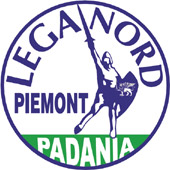 I
see that they put on Verdi’s The Battle of Legnano at San
Carlo the other night for the first time in 142 years. He wrote it in
1849. If it was, indeed, performed in 1861 in Naples, I suspect it must
have been some sort of revolutionary musical salute to the then recent
defeat of the Bourbons and the incorporation of the Kingdom of Naples
into the Kingdom of Italy. (I am not driven by my scholarly demons to
the point of actually finding a concert program from the other night
to see if I have guessed correctly.) That battle, by the way, took place
in May of 1176 between the Lombard League and the forces of emperor
Frederick Barbarossa. Legnano is just a short hop up the A8 autostrada
from Milano (see map 19, coordinate B6 in the fabled 1995 edition of
the Italian Auto Club book, On the Road with ACI.) If you get
confused and wind up in Legnago, then you are way over to the east near
Verona and are hopelessly lost. There is no evidence that this is what
happened to Frederick Barbarossa, but he did lose the battle. And no
one ever wrote an opera about Legnago—though, for the sake of
completeness, I should point out that in 1879 Giosuè Carducci
wrote a poem entitled Song of Legnano, in which he shows no sign
of being confused at all. I
see that they put on Verdi’s The Battle of Legnano at San
Carlo the other night for the first time in 142 years. He wrote it in
1849. If it was, indeed, performed in 1861 in Naples, I suspect it must
have been some sort of revolutionary musical salute to the then recent
defeat of the Bourbons and the incorporation of the Kingdom of Naples
into the Kingdom of Italy. (I am not driven by my scholarly demons to
the point of actually finding a concert program from the other night
to see if I have guessed correctly.) That battle, by the way, took place
in May of 1176 between the Lombard League and the forces of emperor
Frederick Barbarossa. Legnano is just a short hop up the A8 autostrada
from Milano (see map 19, coordinate B6 in the fabled 1995 edition of
the Italian Auto Club book, On the Road with ACI.) If you get
confused and wind up in Legnago, then you are way over to the east near
Verona and are hopelessly lost. There is no evidence that this is what
happened to Frederick Barbarossa, but he did lose the battle. And no
one ever wrote an opera about Legnago—though, for the sake of
completeness, I should point out that in 1879 Giosuè Carducci
wrote a poem entitled Song of Legnano, in which he shows no sign
of being confused at all.
In any
event, the modern Northern League (anti-Federalists who have recently
pulled in their horns a bit on calling themselves “secessionists”*)
call their “nation” Padania (from the Latin adjective for
the Padus river, the Po, in modern Italian) and every year have a party
congress in Legnano to reminisce about the good old days when central
government (Imperial authority) got their cavalry kicked by the locals.
Barbarossa’s grandson, Frederick II, however, soon strode upon
the scene and put Imperial matters right.
(There
is a separate entry about Frederick II.)
(*Not
too long ago, a young flight attendant for Alitalia got herself in trouble—just
as the plane was about to land in Milano—by welcoming passengers
to “the capital of Padania”.)
Cell-phones
(1)
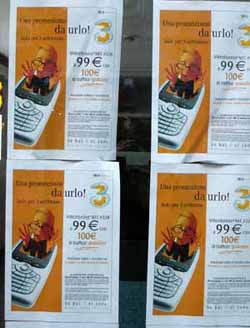 It
used to be that when you saw someone talking to himself on the street,
that was really what he was doing—talking to himself or perhaps
to the Mother Ship. He was just some poor soul “from Aversa,”
as they used to say around here, Aversa (north of Naples) being the
site of the now defunct hospital for the criminally insane. It
used to be that when you saw someone talking to himself on the street,
that was really what he was doing—talking to himself or perhaps
to the Mother Ship. He was just some poor soul “from Aversa,”
as they used to say around here, Aversa (north of Naples) being the
site of the now defunct hospital for the criminally insane.
No more.
The hands-off cellular phone has arrived. Yes, it is still possible
that the man on the corner is channelling the disembodied voice of Artax,
Crown Prince of Atlantis (if he has a voice with a body running
around inside his head, then he is having real problems—you may
wish to stand on a different corner), but, probably, he really is
talking to someone. With that, the world's worst worst (sic) nightmare
has come true. The simply 'worst' nightmare, you will recall, is teenagers
plus telephones. You know, hours and hours of adolescent drivel clogging
the coaxials and keeping the rest of us from getting on with our own
hours and hours of adult drivel. Now, get ready for Son of Worst, to
wit: teenagers plus hands–off cell phones plus motor scooters
in Neapolitan traffic!
Something
had to happen to accommodate people like that kid on the scooter who
turned in front of me yesterday. He had—illegally—two passengers
on the back, was turning left at a busy three–way unmarked crossing
(well, 'unmarked' except for the large sign that said: "Go for it!"),
and was steering through it all with one hand only, since the other
was holding a cell phone, thus permitting him at least the potential
luxury of yakking his way into oblivion. He was also trying to smoke
a cigarette using an auxiliary tentacle that very cool teenagers miraculously
sprout for just such occasions.
I have
nothing against cell phones. I am very impressed by the self-importance
of all those global village peacocks strutting around with their electronic
status toys—into restaurants, movies, churches, shops, bars, funerals,
public restrooms and concerts. Orchestra conductors just love to hear
one ring during the closing pianissimo of, say, Tschaikovsky's sixth
symphony, and when they go off at just the right moment, they can even
heighten the fulfilment of passion (—although some experts now
speculate that that might actually come more from the concussion you
get when you bolt up to answer the phone and whack your skull on the
tin roof of a Fiat 500). And now with the “call waiting”
function, you don't even need two phones to wheel and deal; with one
cell phone, you can always have "Geneva on the other line". The possibilities
are endless.
Anyway,
for that very lucky scooterman in front of me (yes, he made it through
—they always do), the main body of the hands-off voice-activated
cell phone is mounted below the handlebars and is connected by a cable
to earphones and microphone worn by the driver. The smiling young woman
in the ad for the device is, tsk-tsk, not wearing a helmet (nor were
any of the three persons on that motorscooter I missed), but the earphones
can, indeed, be mounted into a regulation noggin guard. At that point,
the ad assures, your incoming call will be totally audible, since it
is virtually sealed off from the distractions of environmental noise.
Such distractions would presumably include not only the dulcet roar
of general traffic, but the sirens of those annoying ambulances trying
to pass you, and the screams of your illegally mounted passengers as
they bounce off your scooter and are dragged with one foot in the stirrup
for a few days or until you decide to get off the damned phone.
You can,
we are assured, keep both hands on the handlebars while you talk. When
your phone rings, your "hello" or "pronto" will activate your microphone
and off you talk. The only drawback, it says in small small small print,
is that in order to dial out, you really should pull over since you
need to punch in the number manually, and you really wouldn't want to
steer with just one hand, would you? Would you?!
One moment.
I have to put you on hold. I have a call from Artax coming in.
Caves
(& tunnels & holes in the ground); streets (2)
(Honeycombing
(undermining?) the hill upon which much of Naples sits are hundreds
of caves such as the one seen in the photo, taken along the Corso Vittorio
Emanuele.)
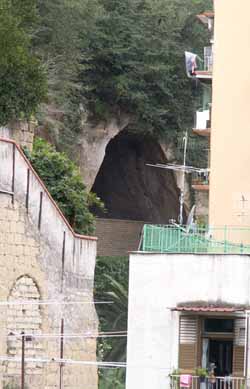 Some
time ago I went to a restaurant at the tiny Piazzetta Leone a Mergellina,
just a block from the small Mergellina harbor. Inside, I asked for the men’s
room and followed directions the way one does—right in there,
around there, back through there. I wound up in a cave—a real
cave. It must have extended 50 yards back from the main restaurant;
it was quite high and all dug out of the hill that separates Mergellina
from Fuorigrotta. The cave was nicely fitted out with the necessary
wherewithal to keep a restaurant going: refrigerators, air-conditioning
units, storage racks, etc. And the men’s room, of course. There
were no bats—at least none that I noticed. Some
time ago I went to a restaurant at the tiny Piazzetta Leone a Mergellina,
just a block from the small Mergellina harbor. Inside, I asked for the men’s
room and followed directions the way one does—right in there,
around there, back through there. I wound up in a cave—a real
cave. It must have extended 50 yards back from the main restaurant;
it was quite high and all dug out of the hill that separates Mergellina
from Fuorigrotta. The cave was nicely fitted out with the necessary
wherewithal to keep a restaurant going: refrigerators, air-conditioning
units, storage racks, etc. And the men’s room, of course. There
were no bats—at least none that I noticed.
As it turns
out, the restaurant is only a few yards from the 700–meter Roman tunnel (popularly called “The
Neapolitan Crypt”) connecting Naples with the area beyond that
mountain, specifically, the area of Fuorigrotta, the important Roman
city of Pozzuoli, and the Imperial
port of Baia. It was built by Lucius Cocceius Aucto, one of the
great architects in the age of Augustus Caesar. He also built the other
tunnel—the “Seiano Grotto”—
two miles up from Mergellina, which burrowed beneath the Posillipo
hill for half a mile. He built another tunnel at Baia, itself, to join
the port facilities to Lake Averno. A busy man, Cocceius. Roman tunnels,
of course, no longer carry traffic, though the Fuorigrotta one was used
much later than one might think. It was actually kept up and expanded
by the Spanish and then the Bourbons in the 1700s. Coach traffic passed
through it well into the 1800s.
In 1925
and 1882-5 two modern tunnels, the “Quattro Giornate”
and the “Laziale”, respectively, were built to join
Mergellina with the north. They flank the “Neapolitan Crypt”
on either side and are heavily used today. The older one, the "Laziale,"
is so called from the adjective for "Lazio," the region where Rome is,
and the tunnel essentially has the same function as the old Seiano one—to
get traffic out of Naples and up the coast towards Rome. Back in the
main part of Naples, there is now also the Galleria della Vittoria,
built in 1927–8; this tunnel joins the center of Naples to the
areas of Chiaia and Mergellina by running from the main port beneath
Monte Echia (or Pizzofalcone), the cliff that overlooks
Santa Lucia and the Castel dell’Ovo
(the “Egg Castle”).
Most recently—opened
about 20 years ago—are the two major tunnels in the city (each
about 1 km long) that form part of the “Tangenziale”,
the road that links Naples with the main Italian autostrada network.
One passes directly beneath the Capodimonte hill and the other beneath
Vomero. There is a third tunnel as the road moves out of the main city
into the area known as the Campi Flegrei.
Tunnels
are just the start when you talk about “underground Naples”.
Sixty percent of the city, they say, “rests on nothing”.
Besides ancient tunnels, aqueducts, cisterns, and catacombs, there
are more than two-hundred (!) quarried sites in Naples—man-made
caves. They have been dug out of the hills of the city in the course
of the centuries, going back to the Greeks, who quarried the stone to
build the original city. Expansion of the city and of the city walls
continued to about the time of the fall of the Roman Empire in the 5th
century. Extensive rebuilding and expansion picked up eight centuries
later under the Angevin rule in Naples and continued well into the 1700s.
The ex-quarries
may be just a few cubic meters in volume, maybe serving as someone’s
garage or storage shed today, or they can be truly mammoth. For example,
the Spanish dug into the hill in the Chaia section of town to build
the Palazzo Cellemare in the 1560s. That man–made cavern
has found various uses through the centuries and, today, has been expanded
even further and converted into an underground seven-screen cinema.
Even larger is the space now occupied by the Augusteo cinema. The entrance
is at the bottom station of the main cable-car on via Toledo, downtown.
It covers an underground area of more than two square miles, and served
as an air–raid shelter in WW2, holding 15,000 persons. Speaking
of cable-cars, there are four of them in Naples, each with its own tunnel
to get from sea-level up to the Vomero and Posillipo sections of town
at around 500 feet; some of the time they run under open sky, but most
of the time they pass right beneath people’s homes.
Also, the
Bourbons dug out an enormous cave beneath the Palace of Capodimonte
in the 1700s. Later, the same dynasty in the 1800s built a large underground
passageway from the Royal Palace downtown along the port and under Monte
Echia to the then new barracks at Chaia. It is said to have been for
the dual purpose of moving troops into the palace area and/or moving
the royal family out in case of trouble.
There are
two older underground railway lines beneath Naples, with one new one
under construction. That makes three separate railways beneath the city
with a total number of 15 underground stations plus more on the way.
Some of the stations are very deep. The deepest and most difficult ones
to build were the ones on the Posillipo hill. It took almost 20 years
to finish them. I almost forgot: there is another underground train
line coming in from the new university and the San Paolo football stadium
in Fuorigrotta. That’s another major tunnel and four or five stations.
I have
barely scratched the surface. (You knew that one was coming.)
There is also some archaeological excavation in downtown Naples. Much
of the historic center of the city actually rests 40 feet above the
original Greco-Roman city, which was covered by a great mudslide in
the sixth century. The excavations to open the Roman market beneath
San Lorenzo took 25 years.
Not surprisingly,
in the course of the centuries, some mythology has attached itself to
the gigantic caves and tunnels of Naples. The average person in southern
Italy during the so-called “Dark Ages”—centuries before
the Renaissance—knew little about his Roman forebears and absolutely
nothing about the ancient Greeks. Who could have hollowed out all the
hillsides to produce the caves? In one example, the Roman poet Virgil was held in such high esteem in the Middle
Ages that he was reputed to have conjured the “Neapolitan Crypt”
into existence a thousand years earlier by his magical powers. Or—another
possibility—perhaps it was the Cimmerians (as in “Cimmerian
darkness”), the mythological race that Homer places near Hades
in an abode of “eternal gloom”. The Greek historian, Strabo,
as well as Roman writers such as Cicero and Pliny the Elder, place this
race of giants near Cuma, near Naples,
and tell of them carving their dwellings out of the hills in order to
hide from the light.
Finally,
in spite of engineers’ claims that much modern construction actually
reinforces the ground we live on, people around here get worried whenever
it rains a lot—as it has this week. Cave–ins are not frequent,
I suppose, but in the back of one’s mind , there is always that
metaphor about the straw that breaks the camel’s back.
Music
(3)
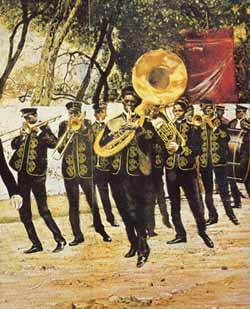 It
was such a good idea. I heard a beautiful baritone voice coming from
around the corner. It was slow and melancholy, but somehow I knew
it was a street vendor pitching his wares. I asked a gentleman near
me what the man was singing, and he didn’t know. I walked around
the corner, and then I saw and heard the band. It was a New Orleans-type
street band playing a slow march, and the marchers that I saw were women
dressed in 19th–century outfits. They wore high pink hats and
long dresses that brushed the ground as they walked. Many of them carried
folded parasols with them that they tapped on the ground as they walked,
as if using a cane or keeping time to the music. I thought, “A
singing street vendor with a New Orleans marching band right here in
Naples! I can’t wait to write about this.” It
was such a good idea. I heard a beautiful baritone voice coming from
around the corner. It was slow and melancholy, but somehow I knew
it was a street vendor pitching his wares. I asked a gentleman near
me what the man was singing, and he didn’t know. I walked around
the corner, and then I saw and heard the band. It was a New Orleans-type
street band playing a slow march, and the marchers that I saw were women
dressed in 19th–century outfits. They wore high pink hats and
long dresses that brushed the ground as they walked. Many of them carried
folded parasols with them that they tapped on the ground as they walked,
as if using a cane or keeping time to the music. I thought, “A
singing street vendor with a New Orleans marching band right here in
Naples! I can’t wait to write about this.”
Unfortunately,
it was a brief dream I had yesterday morning just before I woke up.
I am very upset—even saddened—by this, and I will not be
consoled at all by any load of ontological dingo's kidneys that says
maybe it was all real and what I am doing now is a dream. Save your
breath.
There are,
however, marching bands in Naples. They are parish bands and are usually
made up of not more than four or five members. They parade on the name-day
of the local patron saint. They may have a trumpet, trombone, saxophone
and bass drum, with someone holding the parish banner marching in front.
They parade in the neighborhood around the church; usually there is
someone in the ensemble whose job it is to “pass the plate”
and solicit contributions for the parish.
And, of
course, there are still singing street vendors. They no longer work
from hand–or horse–drawn carts; they drive around in those
horrible tricycle motor–buggies, screaming into microphones that
are cranked up, yea, unto feedback. If their income were a direct function
of decibels, they would be driving a Mercedes. I don’t think I
have ever met anyone who can really understand the whole pitch, sung
as it is, in an old dialect handed down from another century with the
words, themselves, distorted from the process of singing. Even my mother–in–law—then
in her 80s—told me once, “That’s the man with potatoes.”
“How
do you know?” I asked. “What’s he saying?”
“I
know from the melody. He’s probably saying something about potatoes.”
Soccer
(3)
Some
of the many books dealing with violence at soccer matches.
 The term
“Hooligan” apparently derives from an English music hall
song of the 1890s describing a rowdy Irish family. It may be a variant
spelling of the family name, “Hoolihan” or “Houlihan”.
It is not clear if Mark Twain, in The Gilded Age (published in
1873), was using it in a pejorative sense in a reference in that book
to a fictitious novel he invented called The Hooligans of Hackensack.
In any case, by 1898, the word was used in the British press in its
current, generic meaning of “rowdy”. The word got a good
work-out in the form of “hooliganism” in the Soviet Union
to describe general anti-social, anti-Soviet behavior, such as loafing
on street corners and making snide comments about the next 5-year plan.
The word has been taken up into Italian (from the English use of “football
hooligans”) as a synonym for those roughnecks who show up at soccer
matches just to fight and cause trouble. It is more than a bit
hypocritical of Italians to choose a foreign term; it’s as if
they are saying, “We’re so well-behaved at sporting events
that we haven’t even got a word to describe that kind of behavior;
therefore, we cannot behave like that.” The linguistic determinism
underlying that is dubious. Belay that—it’s wrong, but don’t
get me started on the Sapir-Whorf Hypothesis. The term
“Hooligan” apparently derives from an English music hall
song of the 1890s describing a rowdy Irish family. It may be a variant
spelling of the family name, “Hoolihan” or “Houlihan”.
It is not clear if Mark Twain, in The Gilded Age (published in
1873), was using it in a pejorative sense in a reference in that book
to a fictitious novel he invented called The Hooligans of Hackensack.
In any case, by 1898, the word was used in the British press in its
current, generic meaning of “rowdy”. The word got a good
work-out in the form of “hooliganism” in the Soviet Union
to describe general anti-social, anti-Soviet behavior, such as loafing
on street corners and making snide comments about the next 5-year plan.
The word has been taken up into Italian (from the English use of “football
hooligans”) as a synonym for those roughnecks who show up at soccer
matches just to fight and cause trouble. It is more than a bit
hypocritical of Italians to choose a foreign term; it’s as if
they are saying, “We’re so well-behaved at sporting events
that we haven’t even got a word to describe that kind of behavior;
therefore, we cannot behave like that.” The linguistic determinism
underlying that is dubious. Belay that—it’s wrong, but don’t
get me started on the Sapir-Whorf Hypothesis.
The violence
is almost always related to the behavior of fans. They show up in masks
so police cameras can’t identify them, carry tire-irons, throw
bombs onto the field, and are so prone to violence in the stands that
police units have to be stationed strategically to keep opposing rooting
sections apart. International soccer events can be particularly egregious,
as if the fans were acting on some bizarre paraphrase of Clausewitz:
“Sports is the continuation of war by other means.” (“Maybe
we can’t invade you anymore, but just wait till I get you out
in the parking lot!”) Anyone who has ever been to a soccer
match in Naples knows that the stadium is always on the verge of boiling
over into violent behavior. Just a few weeks ago, a member of a visiting
team was stabbed by a fan in the parking lot outside the stadium after
the game. True, individual players on the field may fly off the handle
sometimes—maybe push, shove, throw a punch, make obscene gestures
to each other or even to the crowd, but that is generated by the heat
of the moment and is uncommon.
More to
the point, here, is that I don’t know of an episode of collective
hooliganism on the part of a team, itself, directed against the other
team, the fans, or, say, the referees. Maybe it just goes without saying
that adult professional players couldn’t get away with that kind
of behavior on the field. The players would certainly be expelled from
the game, and—if it really were a case of a whole team being involved—the
team could then be banned from the league.
Kids, on
the other hand, can get away with it. There are in Naples, as elsewhere
in the world, junior leagues for the young to hone their skills in a
variety of sports. There is an active youth soccer league in Naples
for 11–and 12–year–olds. The teams bear the names
of local neighborhoods in the area, and the game last week was between
Bagnolese and Virgilio. The game was apparently heading towards a 3-3
tie, when, in the closing minutes, the referee saw what he judged to
be a penalty in the area of the goal. He blew his whistle and awarded
a free kick on goal. These are a gift and almost always score.
Since these
leagues also serve to train the sports officials of the future, the
referee of the game was, himself, only 15. When he called the penalty
in favor of the home team, the members of the other team resorted to
a typical 12–year–old solution: they swarmed over and beat
him up! He had to be rescued by adult bystanders and taken home by his
mother. One adult spectator attributed this new kind of “hooliganism”
to the tendency of the media to dwell on violence in sports rather than
on the game, itself. Kids watch a lot of tv.
Stamps
 Those
of us…you…who have ever reused a postage stamp or erased
a cancellation so you could reuse the stamp are criminals and will no
doubt be called to account some day. While you are serving hard time
with your fellow felons, meditate on the humbling thought that you are
a piker, a rank amateur, compared to true masters of philatelic
fraud—three of whom appeared a few years ago in the Vomero section
of Naples. I’ve just noticed that the three gentlemen mentioned
below now have their own website, so I guess they never went to jail. Those
of us…you…who have ever reused a postage stamp or erased
a cancellation so you could reuse the stamp are criminals and will no
doubt be called to account some day. While you are serving hard time
with your fellow felons, meditate on the humbling thought that you are
a piker, a rank amateur, compared to true masters of philatelic
fraud—three of whom appeared a few years ago in the Vomero section
of Naples. I’ve just noticed that the three gentlemen mentioned
below now have their own website, so I guess they never went to jail.
For an
entire year, Pierluca Sabatino, Maurizio De Fazio and Lello Padiglione
drew and lettered by computer, then used on postcards and letters,
more than 200 homemade commemorative stamps. None of the stamps were
counterfeits in the true sense of the word. That is, they were not imitations
of real Italian postage stamps. Each one of the phonies was an original
and often biting satirical comment on the times.
One stamp
showed a young hoodlum slouching against a backdrop of the Bay of Naples;
the stamp commemorated "Two Hundred Years of Organized Crime in Naples".
Another issue showed a tank rolling over a sand dune beneath the inscription,
"Finally a War!" And so on, from the commemorative of "The Week
of Putrid and Muddy Water in Naples" to the "First Exhibition of Stolen
Cars," "World Day of the Streetwalker," "Bulldozing Illegal Construction
at Mergellina," and "Don't Waste Your Life on Drugs—Steal!" each
stamp bore a message and an appropriate picture—and each stamp
was duly cancelled by the post-office and delivered to its destination.
Only once did the post-office notice; that was when the denomination
of the phony stamp didn't cover the cost of postage. The addressee had
to pay postage due.
There was
some discussion in the local media as to whether anyone in the post
office ever really noticed the stamps, or whether postal employees,
indulging their own sense of humor at the affair, just looked the other
way.
The Gang
of Three even went out of their way to get caught, always including
their real return addresses and even "issuing" special commemoratives
that read "Check Your Stamps. This Could Be a Fake!" or "First Strike
of Postal Counterfeiters." Nothing. No reaction at all. Apparently,
they got discouraged at the lack of a real challenge and blew the whistle
on themselves. At least that way, they would get some recognition. Now,
they have a website. I guess it worked.
|
